Essential Considerations for Covering Parakeet Cages
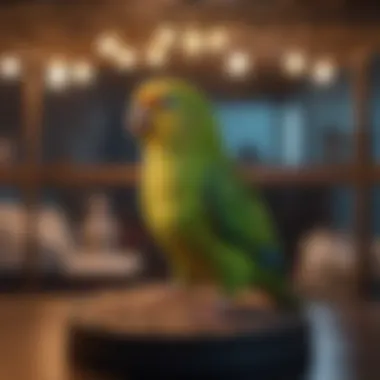
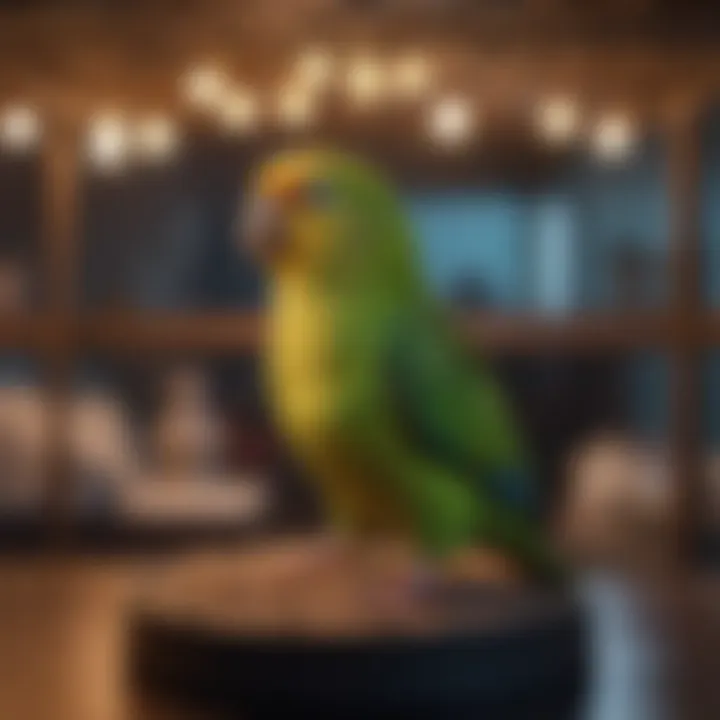
Intro
Covering parakeet cages is a topic that often stirs debate among bird owners. This action can be a more complex decision than many might realize. The choice to cover a cage impacts various aspects concerning the environment of the bird, which in turn influences its health and behavior. This guide aims to address the multifaceted issues of covering parakeet cages and ensure bird owners make informed decisions.
Care Tips
Daily Care Routines
Daily routines serve as the backbone for maintaining a healthy environment for parakeets. Consistency can facilitate bonding and increase the overall well-being of your pet bird. It is crucial to check for accessibility to food and water every day. Make sure settings in the surrounding area align with their natural instincts. Offering regular interaction is just as important as ensuring the cleanliness of the cage.
Cage Setup and Maintenance
Effectively setting up a cage focuses mainly on both comfort and safety. The more stimulating the environment, the cooler it is for your parakeet. Include natural perches made of varying sizes and heights. Pay attention to smart placement of toys, avoiding overstuffing which could cause anxiety. Maintain a clean space by conducting thorough checks regularly.
Hygiene and Cleaning Practices
Hygiene is pivotal for the health of your parakeet. Cleaning the cage thoroughly has a direct impact on the spread of diseases. A weekly scrub of perches, food dishes, and any accumulated debris is recommended. Use bird-safe cleaners. Rinse properly to eliminate any residue that can be harmful. New liners should be applied frequently to control odors and waste accumulation.
Seasonal Care Adjustments
Different seasons bring unique challenges requiring adjustments. For example, during warmer summer months, ensure proper ventilation inside the cage. In contrast, colder weather necessitates warmer coverings that prevent drafts. Monitor temperature and humidity as these can directly affect the living conditions of your bird.
Behavioral Insights
Understanding Bird Body Language
Birds communicate non-verbally through body language. Understanding wing positioning, bobbing, or tail-flicking can potentially inform you about their mood. A relaxed parakeet typically exhibits an upright posture, whereas puffing feathers may indicate discomfort.
Common Behavioral Issues and Solutions
Behavior possibly results from a myriad of factors. Some commonly observed issues are feather plucking and stressed vocalizations. Observe changes that might trigger these responses. Solutions may range from environmental enrichments to consulting knowledgeable avian professionals.
Positive Reinforcement Techniques
Using positive reinforcement is a behavioral strategy that yields great success. Presenting treats during training help parakeets understand expected behaviors like returning to the perch after flight.
Social Interaction Needs
Social interactions can directly impact your parakeet’s happiness. They thrive in an environment abounding in engagement and stimulation. Consider incorporating a trusted routine where bonding and play is prioritized.
Nutrition Guides
Essential Diet Components
A balanced diet enrolling a variety of components is crucial for a parakeet’s life. Seeds alone lack fundamental nutrients needed for growth. A mixture of high-quality pellets, fresh fruits, and leafy vegetables ensures complete nourishment.
Safe and Toxic Foods
It is vital for bird ownersรู้ to understand which foods are safe and which can be harmful. Safe options include apples, broccoli, and quinoa. Dangerous foods encapsulate chocolate, avocado, and caffeine. Always verify whether specific foods are harmful before offering.
Supplements and Treats
While primary food sources lay the foundation, supplements can offer necessary nutrients missing in a regular diet. Natural mineral blocks serve additional support.
Feeding Strategies for Different Species
Feeding requirements can vary across species. Each has unique diets that contribute toward their overall health. Engage in research tailored to your specific type of parakeet.
Wellness and Health
Routine Health Checkups
Partaking in regular health check-ups should be a practice for any parakeet owner. These inspections target common health issues early before behaviorally noticeable symptoms surface.
Identifying Symptoms of Illness
Being vigilant for changes in behavior can alert you to potential health concerns. Lack of appetite, changes in vocalization, or unusual droppings signal distress and warrant attention.
Preventative Care and Vaccinations
Preventative care forms the bedrock of long-term health. Depending on circumstances, vaccinations offer protection against diseases common among aviaries. Consult with a veterinarian to evaluate your bird’s vaccination needs.
Mental and Emotional Well-being
Mental and emotional health shouldn't take a back seat. Birds experience emotions similar to humans. Therefore, ignoring their holistic needs can lead to increased panic or stress factors over time.
Enriching Activities
Toys and Playtime Ideas
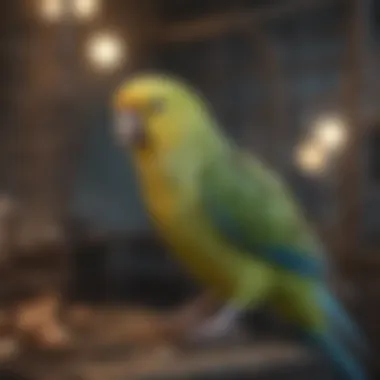
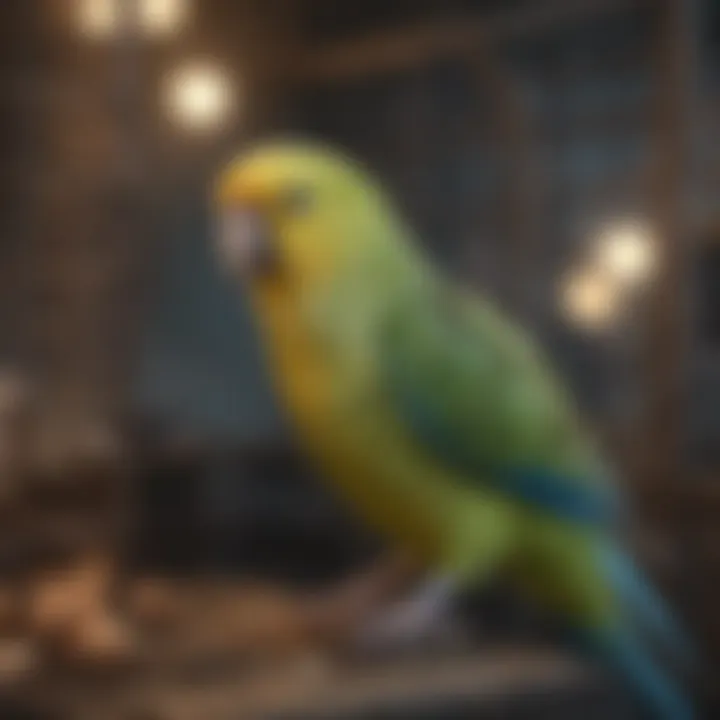
Play serves as a vital component for staving off boredom. A range of toys will keep your parakeet engaged. Materials like wood and plastic offer diversity.
Training and Tricks
Offering training not only engages a parakeet's mind but facilitates bonding. Encourage them to learn basic tricks using positive grammar.
Outdoor Activities and Interaction
Integrating outdoor time promotes a broader scope of exploration which benefits their confidence and curiosity about the world.
DIY Projects for Mental Stimulation
Birds are intelligent creatures. Employing DIY projects can innovate stimulation for them. Simple tasks like creating puzzles build a bird's problem-solving capabilities without wealth demands.
Maintaining a consistent care routine can enhance your bird’s health and happiness significantly.
By focusing on the crucial facets like daily routines, welfare and proper nutrition, pet literature encourages aspiring avian guardians to recognize that life entails beautiful depth—as does their beloved parakeets.
Prologue to Covering Parakeet Cages
Covering parakeet cages is a practice that often requires more thought than one might initially assume. For many pet bird owners, the idea might stem from ensuring their pets are shielded from external factors or providing a comfortable rest environment. However, it goes much deeper. Understanding the reasons for covering a cage and the implications thereof is integral to fostering an optimal environment for these communicative creatures.
One key consideration is the comfort of the parakeet. These birds are quite sensitive to changes in their surroundings, and exposure to excessive light at night can lead to disrupted sleep patterns. Consequently, a simple cover over the cage can promote a peaceful resting atmosphere, akin to creating a designated dark space that signals bedtime.
Moreover, a covered cage can assist with temperature regulation. In a household where environmental fluctuations occur, Thsufficient coverage can create a more stable climate for parakeets, protecting them from drafts or direct heat from nearby locations.
Selecting appropriate covering materials also warrants significant attention. Not just any fabric will do; it must be breathable and impede odors while ensuring safety for the bird. A poor choice here can lead to additional stress for the parakeet, thereby contradicting the purpose of such coverage.
Lastly, covering cages effectively encourages a controlled ambience. Birds, being naturally curious, can become easily anxious. A well-thought-out covering method can shelter them, eliminate distractions, and foster an inclination towards calm behavior.
In summary, the importance of covering parakeet cages spans several domains—from health to environmental stability. The impacts can resonate profoundly on the bird's overall well-being, making understanding this subject a priority for pet owners aiming to create thriving living conditions for their avian companions.
Understanding Parakeet Behavior
Understanding the behavior of parakeets is crucial when considering how to cover their cages. Parakeets, like all birds, possess natural instincts and habits that can greatly influence their health and well-being.
A fundamental aspect is recognizing their need for a secure environment. In the wild, parakeets will use foliage to hide from potential predators. Thus, providing a cover can mimic that sense of security in captivity. Not only does this increase their comfort, but it can also lead to a more relaxed and less stressed bird.
Natural Habits and Habitat
Parakeets are inherently social and curious creatures, with intricate behaviors that showcase their intelligence. In the wild, they spend their days foraging, exploring, and socializing with their flock. Understanding that these birds thrive in an enriching environment helps in replicating a suitable habitat in captivity.
The patterns of movement in natural habitats are influenced by factors such as the seasons and the availability of food. Owners should simulate such conditions whenever possible. Offering a stable yet dynamic environment—one that incorporates different play and perch options—provides mental stimulation. Covering their cage can help in creating a familiar setting for rest and nesting, essential for their mental state.
Effects of Light and Darkness
The impact of light and darkness on parakeet behavior is profound. Birds need exposure to natural light to regulate their circadian rhythms. When covered, cage lighting must be taken into account. Too much artificial light can confuse their biological clocks, leading to health problems, including disrupted sleep cycles.
A balanced light routine is critical. A partial cover can be an effective solution, providing shelter while allowing natural or low lighting.
In general, controlled exposure to light can enhance their mood, alleviate stress, and support a healthy sense of time, thus directly impacting their overall behavior.
Ensuring that your parakeet has the right balance of light allows them to feel secure and promotes proper activity patterns.
Why Cover a Parakeet Cage?
Covering a parakeet cage serves multiple purposeful functions that directly impact the health and welfare of these birds. Understanding the benefits of this practice can enhance the well-being of your parakeet significantly. Three major considerations arise when determining whether to cover your parakeet's cage: fostering a calm environment, regulating temperature, and ensuring darkness for proper rest.
Fostering a Calm Environment
A covered cage can create a sense of security for parakeets. In their natural habitats, these birds often seek hidden spots to escape from potential threats. By covering the cage, it simulates a more enclosed space, minimizing stress factors like excessive noise, sudden movements, or bright lights. A calm atmosphere further allows your parakeet to feel relaxed.
Many birds respond positively when they are given the option to retreat into a quiet space. During high-activity times or when household events occur, covering the cage can help reduce anxiety and foster peace. Additionally, a calm environment supports healthy bird behaviors, thereby promoting confidence.
Temperature Regulation
Another essential reason for covering a parakeet cage is temperature regulation. These birds are susceptible to extreme temperatures and sudden temperature changes. A cage cover can help maintain a stable climate, particularly during colder periods. The fabric traps warmth inside the cage, providing a cozy environment for your pet.
Conversely, using the cover during warmer weather can prevent direct exposure to scorching sunlight, which can lead to overheating. It is important to ensure that the fabric chosen is breathable to allow enough circulation while controlling temperature. Lagging temperature can negatively affect their activity level and overall health.
Darkness for Rest
Adequate rest is vital for any pet bird, including parakeets. In stimulating environments, they may not recognize when it is time to wind down. An effective way to promote a healthy sleep schedule is to cover the cage during night time or nap times. Darkness signals to the parakeet that it is time to sleep, thereby regulating their internal clock.
It's also crucial to monitor how much light exposure your parakeet receives daily. Most birds prefer to have around 10-12 hours of darkness each night. This helps strengthen their natural routines, reduces stress, and can positively influence their longevity.
Covering a parakeet's cage, when performed correctly, can significantly improve their quality of life. Each of these outlined considerations, from fostering calmness to ensuring darkened rest periods, are integral for establishing a happier and healthier environment for your pet.
Materials for Covering Cages
Choosing the right materials for covering parakeet cages is an essential element in ensuring the well-being and comfort of your bird. The material not only affects how well the cage is covered but also has practical implications for your parakeet’s health and safety. A suitable cage cover can provide security, regulate temperature, and influence light exposure, making the selection of materials paramount.
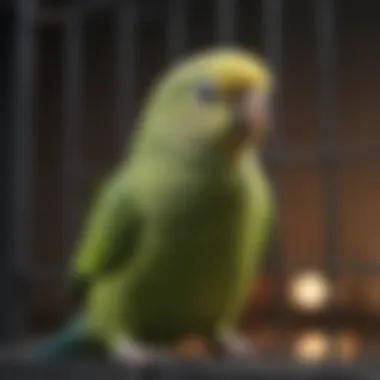
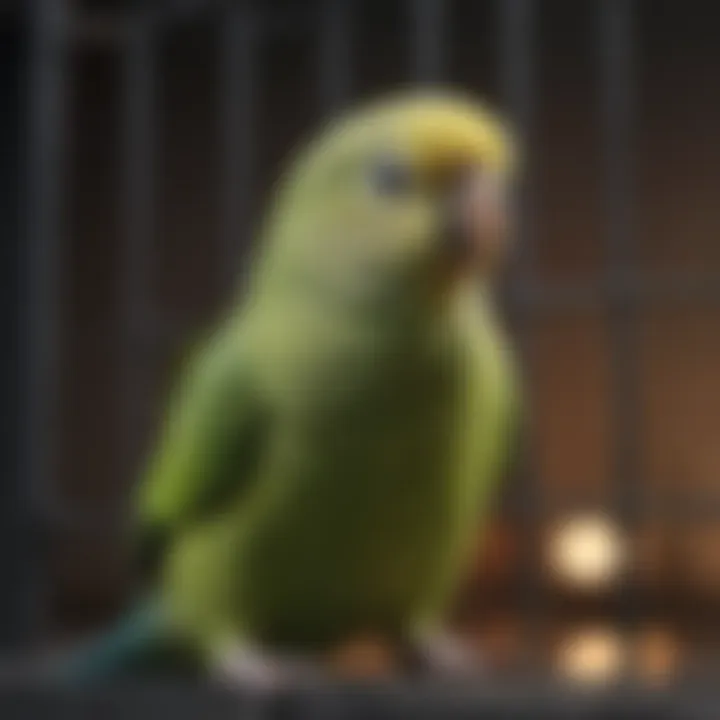
Types of Fabric Choices
When it comes to fabrics, parakeet owners have various options. Commonly used materials in making cage covers include cotton, polyester, and breathable mesh fabric. Each has distinct properties suitable for different circumstances:
- Cotton is a natural fiber that allows for good airflow while providing some warmth. It is easy to wash and usually hypoallergenic.
- Polyester covers are durable and resistant to wrinkling and shrinking. They often offer better protection against humidity, but may not insulate heat as well as cotton.
- Breathable mesh fabric serves the purpose of providing ventilation while also offering some level of shade. This option is particularly convenient for daytime coverage.
Experimenting with various fabrics based on seasonal temperature and your pet’s comfort will lead to more effective covering solutions.
Breathability and Safety Concerns
The breathability of the material used is a crucial factor that must not be overlooked. Inadequate airflow can create a humid environment within the cage, presenting risks for respiratory health. On the other hand, covers that allow for ventilation can help avoid the trends of rapid temperature changes during colder months.
Additionally, consider safety concerns concerning any potential toxins that fabrics may emit, particularly in synthetic materials. Make sure to choose covers that are pet-safe, non-toxic, and free from harmful dyes. Parakeets are more susceptible to environmental pollutants than most other pet species;
- Opt for those fabrics made with non-toxic materials.
- Regularly inspect the fabric for wear and tear or signs of fading before applying it to your cage.
In summary, selecting the right materials for covering parakeet cages entails evaluating fabric types and ensuring breathability and safety. This simpler, conscious approach to material selection can foster an environment conducive to your bird's health and comfort.
Best Practices for Covering Cages
Covering parakeet cages involves more than aesthetics; it plays a role in the overall health and comfort of the bird. Adopting best practices for covering ensures that you create a serene environment conducive to well-being. Specific considerations when covering cages include the choice of material, techniques for application, and the timing of coverage. An attentive approach can prevent stress and foster a more comfortable habitat for your pet.
Covering Techniques
First, let's explore various methods of covering parakeet cages. The goal is to create an environment that mimics their natural surroundings while providing safety. A common method is to use a flat cover that drapes over the entire cage. This option allows flexibility in adjusting the cover depending on the level of light or air circulation conditions in the room.
Another technique is to use partial coverage with light weight fabric. Doing this permits some light but still offers a darkened corner where your parakeet can rest. Always opt for breathable materials. Fabrics like cotton or special bird-safe microfiber are commonly preferred due to their breathability and light management abilities.
Check that the cover you choose is lightweight and can be easily removed for cleaning or adjusting. Weighty covers could restrict airflow, which can be harmful for your parakeet. Moreover, ensure any covers do not entangle or pose a potential choking hazard.
Timing and Duration of Coverage
Understanding when to cover the cage is equally critical. Most parakeets benefit from routines, as that allows them to adapt easily. Covering should ideally align with natural light conditions, which means continuously assessing local day-to-day light patterns.
During evening hours, gradual dulling of brightness might signal it's time for covering the cage. Experts recommend having a set duration that syncs accurately with your bird’s sleep cycle as well. Ensuring that your bird receives about ten to twelve hours of undisturbed darkness per night is very important.
Here are some points to remember:
- Use timing to create a predictable environment.
- Avoid sudden changes in covering time.
- Adjust coverage based on the season; darker winters may require earlier covering.
Ultimately, the best practices surrounding covering parakeet cages offer an opportunity to enhance the bird’s quality of life. These elements can lead to improved stress levels, more confident behaviors, and a healthier mindset for your feathered companion.
Common Misconceptions about Cage Covers
Covering parakeet cages is a practice that invites various misconceptions. Understanding these can greatly affect the decision-making process for parakeet owners. Many people assume that a covered cage is synonymous with isolation. This belief often stems from personal interpretations of how keeping a cover over a cage might limit a bird's interaction with the environment. However, this perspective can lead one to overlook the significant benefits that controlled coverage can offer. While covering may seem like a method of secluding a parakeet from its surroundings, it actually fosters a sense of security which can play a vital role in maintaining its overall well-being.
Another common misunderstanding is the idea that parakeets naturally prefer to be uncovered. Some owners think their pets will feel more comfortable without a cover. In reality, a parakeet's preference is not necessarily related to being visible at all times. They are instinctively wired to find and seek shelter during times when they feel vulnerable. Thus, exposure to bright light or loud sounds can trigger stress or anxiety for some birds. Knowing this allows us to realize that offering the option to cover contrasts with the belief in a parakeet’s consistent longing for visibility and freedom.
Informed choice on whether to cover a parakeet cage hinges on understanding individual behavior and environmental factors, not on generalized notions.
The implications of these misconceptions highlight the importance of focusing on each parakeet's personal needs. Each bird varies in terms of tolerance to light, noise, and social interaction, meaning their covering preferences can differ widely as well. By centering coverage customizations around these aspects, owners can create a healthful and secure environment for their pets. Understanding these intricacies is fundamental in crafting a supportive setting that encourages well-being.
Effects of Isolation
There is a prevalent yet faulty belief that covering a cage leads to feelings of isolation for a parakeet. In effect, isolation and security often share a delicate line that can easily expound on existing biases among owners. While it may seem intuitive to think covering one side of a parakeet’s world reduces its exposure to social stimuli, the very objective of this practice calls into question whether this leads to harmful consequences. Natural instinct dictates that parakeets thrive under specific amounts of light and shelter. Invoking tastefully applied coverage offers a sense of safety rather than severing social bonds.
In fact, the predominant factor lies in just how well the owner understands their bird’s behavioral patterns. For some, visibility might cause stress—affecting their eating habits or engagement with toys. Recognizing signs of unease such as vocalization imbalance can reveal whether a covered cage serves as a fortress or a burden.
Preference of Coverage
When considering the preferences of coverage, personal owner insight becomes essential. It is easy to mask an individual parakeet's needs under assumptions derived from sweeping generalizations. A common belief sways toward fully uncovered cages, leading people to create otherwise unnecessary struggles for integrating their pets into household settings. However, examining varying reactions to coverage shows levels of comfort differ between various birds. Notably, certain birds may benefit from having a dimly lit environment when covered, equating this setup with cozy surroundings they often find in their habitats.
Acclamation to coverage further lends itself to trials and error conducted by diligent pet owners. Three differing scenarios reveal potential preferences:
- The observant parakeet that thrives in half-covered environments.
- The shy bird seeking solace in fully covered surroundings.
- The assertive parakeet thriving while noticeably out in the open.
Finding an ideal scenario takes thoughtful experimentation accompanied by observed outcomes. Ultimately, recognizing that covering encompasses a dichotomy twists perception away from restrictive isolation and lands it into positively weighted options. All in all, initiated adjustments to the coverage over minutes can lead to significant understanding of behavior, inviting improved environments suitable for each unique individual.
In forming a nuanced view of cage coverage, misconceptions can fall silent in favor of informed dialogue guided by individual parakeet needs and innate behaviors.
Monitoring Parakeet Health Under Covers
Monitoring the health of parakeets in relation to their cage cover is essential. The approach taken to cover the cage greatly affects how these birds feel in their enclosed environment. Proper monitoring helps ensure that the well-being of the bird is prioritized. It also aids in understanding how coverage affects their behavior and psychological health. Surveillance on signs of stress or anxiety and adjusting coverage based on observable behavior is vital.
Signs of Stress or Anxiety
Parakeets, like many pets, communicate through subtle changes in their behavior. Identifying signs of stress or anxiety can help owners address issues before they escalate. Some common indicators are:
- Loss of appetite
- Excessive preening
- Avoidance of human interaction
- Loud vocalizations or silence that deviates from usual behavior
These signs may emerge post-covering or even when transitioning to a new covering material. Being vigilant to these changes allows for timely interventions, keeping parakeets healthier and more comfortable.
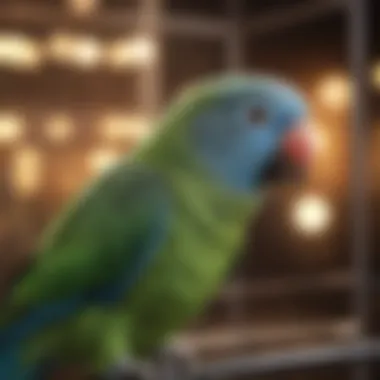
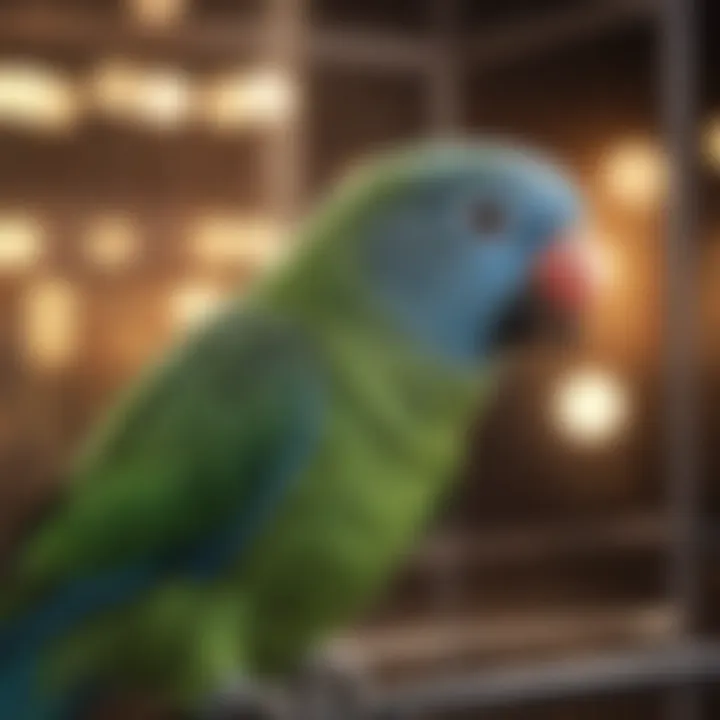
For instance, if a parakeet becomes unusually aggressive or appears withdrawn, coverage may need adjusting. Providing a breathable cover might significantly benefit birds that experience heat or discomfort during materials transition.
Adjusting Coverage Based on Behavior
Understanding parakeet reactions when they are covered creates opportunities for owners to adapt their strategies. Birds can differ widely in how they react to covers, so here are some key strategies:
- Monitor reactions closely after first covering: Take notes on the parakeet's general demeanor and their vocalizations. If possible, introduce them to the covering gradually.
- Experiment with methodologies: Adjust the time and materials used. For example, using lighter fabrics in hot weather can aid ventilation.
- Observe temperature reactions: If a parakeet seems uncomfortably warm, reevaluating the cover's thickness might be necessary. Conversely, apossed chilling may require additional layers.
Through continuous focus on their behavior and tailoring the coverage approach, pet owners will likely notice improvements in overall health of their parakeets. Keeping a journal to record behavioral responses can provide deeper insights to help refine the process over time.
Regular monitoring and adaptation lead to a happier parakeet, which in turn fosters true pet-bird companionship.
Notably, a healthy parakeet is less prone to stress-related symptoms, further emphasizing the importance of keen observation and timely adjustments. Each activity helps forge a bond and promotes wellness in the parakeet throughout their life stages.
Environmental Considerations
When considering the environment of a parakeet, the overall aspects of its living space cannot be overlooked. Key elements to note include noise levels and the cage's location. These factors come into play whenever bird owners decide whether to cover their birds' habitats or not. Here, we will explore these important considerations and how they can impact the well-being of your parakeet.
Noise Levels and Their Impact
Parakeets are sensitive creatures influenced by their surroundings. High noise levels can lead to stress or anxiety for these small birds. It is not just loud sounds; even continuous mild noise can disrupt their peace. To create a soothing environment when covering a parakeet cage, consider whether to use the covering effectively to muffle these disturbances.
If the cage is located in a noisy area, covering may help to bring down the stress level by absorbing some of the sounds. Good materials that gently obscure sounds include wool and multiple layers of fabric. You may see a change in your bird’s behavior over time when it is sheltered from incessant noise.
- Potential behavioral responses to noise:
- Increased vocalization
- Signs of aggression
- Frequent hiding or retreating within the cage
Fluctuating noise levels calls for monitoring and adjusting the covering strategy to ensure your parakeet remains calm and comfortable.
Location of the Cage
The location of the parakeet's cage plays a critical role in determining the overall environment for the bird. An ideal spot is away from pathways and communal areas where people gather. Excess foot traffic can be unsettling for parakeets, as they may feel exposed and insecure.
It is best to place the cage in a quieter room but still in the heart of the home to maintain interaction. Covering the cage at night can prevent disruptions from both light and noise that occur after a long day.
Things to consider when selecting a cage location include:
- Sunlight exposure: Parakeets need a healthy amount of light during the day. Pick a spot that catches indirect natural sunlight throughout the day but avoid direct exposure that can overheat the cage.
- Drafts and temperature fluctuations: Keep the cage away from heating vents or open windows to ensure stable and comfortable conditions. Checking for drafts becomes even more critical if you are covering the cage to manage temperature effectively.
Careful evaluation of these environmental considerations results in forming a better habitat for your parakeet, positively influencing its daily life and overall health. You are in a unique position to improve their well-being through intentional decisions on covering strategies and cage placement.
Evaluating Your Approach
Evaluating your approach to covering parakeet cages is an essential element in ensuring your pet’s overall health and comfort. Making adjustments based on observations allows for an informed and responsive strategy when safeguarding your bird's well-being. It involves critically analyzing your current methods and their effects on your parakeet's behavior. Considering specific aspects, such as coverage materials and timing, is equally vital.
A tailored approach can yield several benefits:
- Maintains optimal comfort for your parakeet.
- Provides positive behavioral outcomes, reducing stress and anxiety.
- Fosters a conducive environment for auditory and visual bonding.
A keen assessment of your methods can help refine your strategy when covering your parakeet's cage, ensuring the care you offer continuously meet their needs.
Trial and Error in Covering
Engaging in trial and error is a practical approach for optimizing cage coverage. Every parakeet is unique, and their responses may vary depending on individual characteristics and preferences. Experimentation allows you to discover what works best for your bird.
Consider the following aspects in your trial process:
- Material Experiments: Try different types of fabrics like cotton, silk or polyester, and observe the responses.
- Coverage Duration: Gradually increase or decrease the time spent covering the cage each day and monitor effects on sleep quality.
- Light Conditions: Experiment with how much light penetrates the cover during day and night, adjusting based on your parakeet’s reactions.
Recording these observations can aid in identifying patterns in behavior, allowing you to make more tailored modifications. This process not only improves comfort but also strengthens your insight into parakeet well-being.
Feedback from Avian Experts
Acquiring feedback from avian experts can greatly enhance your approach to cage coverage decisions. Expert advice provides knowledge drawn from extensive experience with various breeds, behaviors, and environmental needs.
Here are some approaches to engaging with professionals in the field:
- Consultation: Schedule an appointment with a vet specializing in avian health to discuss covering practices and any concerns.
- Workshops: Attend seminars that focus on pet bird care, often run by experienced avian behaviorists or trainers.
- Online Forums: Engage in discussions on platforms like Reddit or join Facebook groups centered around bird care to gain insights by sharing experiences with other bird owners.
“Every attempt you make, whether successful or not, is an opportunity to learn more about your bird’s needs.”
By leveraging expert feedback, you gain a wider perspective on best practices and valid alternatives. This way, your approach evolves in harmony with the latest understanding in avian care, benefitting the overall health of your beloved parakeet.
Epilogue
In concluding the discussion on covering parakeet cages, it is essential to acknowledge the significance of this practice in creating a nurturing environment for pet birds. Covering a cage serves various purposes that can greatly enhance the quality of life for parakeets. First, it fosters a sense of security by mimicking their natural habitat, giving them a place that resembles a cozy nook or safe spot.
Furthermore, implementing proper coverage can significantly control light exposure. Parakeets require a balance of light and darkness, which directly impacts their circadian rhythm. A consistent nighttime routine promotes healthy sleeping patterns and overall wellbeing. Thus, mastering the balance of coverage becomes crucial for ones who wish to maximize their pet's comfort.
Safety is another key concern when covering parakeet cages. Body warmth needs to be preserved while ensuring sufficient airflow via breathable materials is vital. The type of fabrics chosen can influence both temperature control and anxiety levels among the birds. Hence, understanding how to effectively cover a cage, backed with appropriate materials, will benefit both owner and pet alike.
Here are some final considerations to keep in mind:
- Experiment with different covering methods to find what suits your parakeet best.
- Regularly observe their reactions and adjust coverage accordingly.
- Consult avian specialists for personalized advice based on behavioral cues.
More than just aesthetics, proper cage covering should emphasize health benefits, safety protocols, and comfort measures. A careful, informed approach derived from the facts detailed in this article ensures that bird owners are well-equipped to provide an environment that focuses on the remarkable needs of parakeets. By prioritizing these factors, one can not just enhance the comfort of these splendid creatures but also solidify a bond based on nurturing care.















